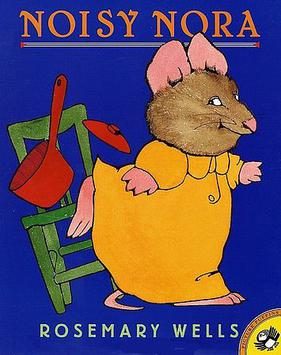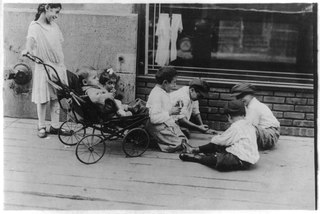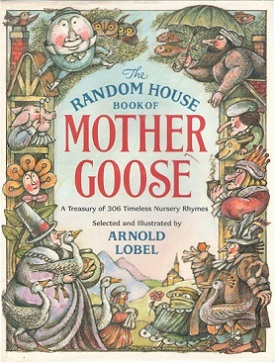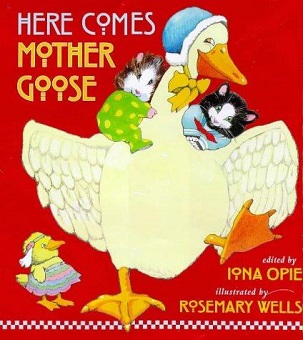
A nursery rhyme is a traditional poem or song for children in Britain and many other countries, but usage of the term dates only from the late 18th/early 19th century. The term Mother Goose rhymes is interchangeable with nursery rhymes.

Humpty Dumpty is a character in an English nursery rhyme, probably originally a riddle and one of the best known in the English-speaking world. He is typically portrayed as an anthropomorphic egg, though he is not explicitly described as such. The first recorded versions of the rhyme date from late eighteenth-century England and the tune from 1870 in James William Elliott's National Nursery Rhymes and Nursery Songs. Its origins are obscure, and several theories have been advanced to suggest original meanings.

The figure of Mother Goose is the imaginary author of a collection of French fairy tales and later of English nursery rhymes. As a character, she appeared in a song, the first stanza of which often functions now as a nursery rhyme. This, however, was dependent on a Christmas pantomime, a successor to which is still performed in the United Kingdom.

"Peter Peter Pumpkin Eater" is an English language nursery rhyme. It has a Roud Folk Song Index number of 13497.

"Ring a Ring o' Roses", "Ring a Ring o' Rosie", or "Ring Around the Rosie", is a traditional nursery rhyme, folk song and playground singing game. Descriptions first emerge in the mid-19th century, but are reported as dating from decades before, and similar rhymes are known from across Europe. It has a Roud Folk Song Index number of 7925.

"Baa, Baa, Black Sheep" is an English nursery rhyme, the earliest printed version of which dates from around 1744. The words have not changed very much in two and a half centuries. It is sung to a variant of the 1761 French melody Ah! vous dirai-je, maman.

A children's song may be a nursery rhyme set to music, a song that children invent and share among themselves or a modern creation intended for entertainment, use in the home or education. Although children's songs have been recorded and studied in some cultures more than others, they appear to be universal in human society.

"One, Two, Buckle My Shoe" is a popular English language nursery rhyme and counting-out rhyme. It has a Roud Folk Song Index number of 11284.

"Pease Porridge Hot" or "Pease Pudding Hot" is a children's singing game and nursery rhyme. It has a Roud Folk Song Index number of 19631.
"Goosey Goosey Gander" is an English-language nursery rhyme. It has a Roud Folk Song Index number of 6488.

"There was an Old Woman Who Lived in a Shoe" is a popular English language nursery rhyme, with a Roud Folk Song Index number of 19132. Debates over its meaning and origin have largely centered on attempts to match the old woman with historical female figures who have had large families, although King George II (1683–1760) has also been proposed as the rhyme's subject.
Rosemary Wells is an American writer and illustrator of children's books. She is well known for using animal characters to address real human issues. Some of her most well-known characters are Max & Ruby, Noisy Nora, and Yoko.
Iona Margaret Balfour Opie, and Peter Mason Opie were an English married team of folklorists who applied modern techniques to understanding children's literature and play, in studies such as The Oxford Dictionary of Nursery Rhymes (1951) and The Lore and Language of Schoolchildren (1959). They were also noted anthologists, assembled large collections of children's literature, toys, and games and were regarded as world-famous authorities on children's lore and customs.

Noisy Nora is a 1973 children's picture book by Rosemary Wells. It is about a mouse called Nora who likes to make lots of noise.

Childlore is the folklore or folk culture of children and young people. It includes, for example, rhymes and games played in the school playground. The best known researchers of the field were Iona and Peter Opie.

‘Little Robin Redbreast’ is an English language nursery rhyme, chiefly notable as evidence of the way traditional rhymes are changed and edited. It has a Roud Folk Song Index number of 20612.

Mother Goose's Little Treasures is a 2007 children's picture book by Iona Opie. It is a collection of nursery rhymes, some little known, chosen by Opie from the Mother Goose oeuvre.

The Random House Book of Mother Goose: a Treasury of More Than 300 Classic Nursery Rhymes is a 1986 collection of over 300 nursery rhymes by Arnold Lobel. It was republished in 1997 as The Arnold Lobel Book of Mother Goose.

Here Comes Mother Goose is a children's picture book by Iona Opie. It is a collection of 56 Mother Goose nursery rhymes, chosen by Opie and is the second such collaboration between her and illustrator Rosemary Wells.
















